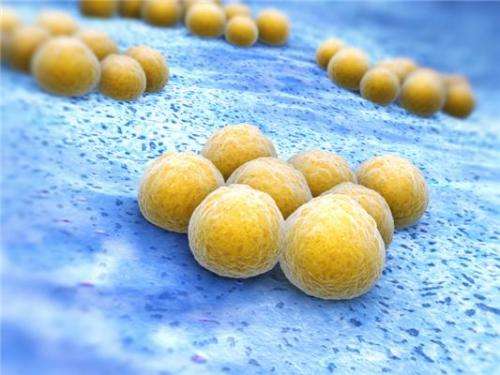Unique multi-resistant bacterium difficult to eradicate

A previously unknown multi-resistant bacterium has been sticking around at a Swedish University Hospital for ten years. The reason for this is deficient hygiene routines among the staff, a doctoral thesis at Linköping University shows.
During 2005-2006 Östergötland County suffered a major outbreak of methicillin-resistant Staphylococcus aureus, or MRSA.
"In connection with the MRSA outbreak, an increased occurrence of MSSA was discovered, a strain that was sensitive to methicillin but resistant to many other types of antibiotic. This was a completely new find," says Maria Lindqvist, a PhD student in clinical microbiology. The results are set out in her doctoral thesis.
The analysis of this multi-resistant MSSA showed that 91% were clonal, meaning genetically related, and that the majority came from elderly patients with infected wounds. The clonal outbreak was concentrated in eight nursing wards at the University Hospital and two primary health care centres in the same town, Linköping. Despite a large exchange of patients in the southeast medical care region – more than 8,000 patients from Jönköping County and Kalmar County are referred each year to US – the clone was limited to Linköping.
Genetic analysis showed that this probably stems from a successful strain of MRSA, but where and how it arose is unclear. The most notable thing is that the clone established itself and after ten years it is still present in the hospital.
"The reason for this is that staff are careless with their hygiene routines. They do not disinfect their hands carefully enough, they use long-sleeved work clothes, or wear watches or jewellery," says Ms Lindqvist.
Since the hygiene nurses visited the affected departments the situation has improved but the clone probably has mechanisms for virulence and spreading, which is what make it so successful.
Hospital-related infections are spread directly by contact between patients, the hands or clothes of the nursing staff, or indirectly via unclean instruments. Common infections arise in operation wounds, urinary tracts, the blood stream and the lungs. In-patients are more vulnerable due to things such as weaker immune defence and long-term antibiotic treatment.
More information: "Epidemiological and molecular biological studies of multi-resistant methicillin-susceptible Staphylococcus aureus." Linköping University Medical dissertations No. 1386: urn.kb.se/resolve?urn=urn:nbn:se:liu:diva-103679













